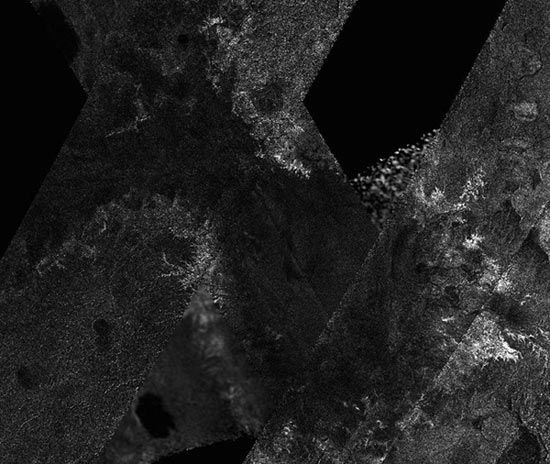Titan: A World Much Like Earth

Saturn?smoon Titan may be worlds away from Earth, but the two bodies have somecharacteristics in common: Wind, rain, volcanoes, tectonics and otherEarth-like processes all sculpt features on Titan, but act in an environmentmore frigid than Antarctica.
"It isreally surprising how closely Titan's surface resembles Earth's," saidRosaly Lopes, a planetary geologist at NASA's Jet Propulsion Laboratory (JPL)in Pasadena, Calif., who is presenting the results of two new studies at theannual meeting of the of the International Astronomical Union (IAU) in Rio deJaneiro, Brazil on Friday. "In fact, Titan looks more like the Earth thanany other body in the solar system, despite the huge differences in temperatureand other environmental conditions."
This viewof Titan comes from observations made by the Cassini-Huygens mission, which hasrevealed details of Titan's geologically young surface, showing few impactcraters, and featuring mountain chains, dunes and even "lakes."
The RADARinstrument on the Cassini orbiter has now allowed scientists to image a thirdof Titan's surface using radar beams that pierce the giant moon's thick,smoggy atmosphere. As its name implies, Titan is no small moon, with a sizeapproaching that of Mars.
Titan getsabout 1 percent the amount of sunlight Earth receives.
Titan isthe only moon in the solar system known to possess a thick atmosphere, and itis the only celestial body other than Earth to have stable pools of liquid onits surface. Lakes that pool on Titan's surface are thought to be filled notwith water, but withliquid hydrocarbons, such as methane and ethane.
"Withan average surface temperature hovering around -180 C [-292 degreesFahrenheit], water cannot exist on Titan except as deep-frozen ice as strong asrock," Lopes said.
Get the Space.com Newsletter
Breaking space news, the latest updates on rocket launches, skywatching events and more!
On Titan,methane takes water's place in the hydrological cycle of evaporation andprecipitation (rain or snow) and can appear as a gas, a liquid and a solid.Methane rain cuts channels and forms lakes on the surface and causes erosion,helping to erase the meteorite impact craters that pockmark most other rockyworlds, such as our own moon and the planet Mercury.
Other newresearch presented at the IAU General Assembly points to current volcanicactivity on Titan, but instead of scorching hot magma, scientists think these"cryovolcanoes"eject cold slurries of water-ice and ammonia.
The ammoniasignature seems to vary, which suggests that ammonia frosts are ejected andthen subsequently dissipate or are covered over. Although the ammonia does notstay exposed for long, models show that it exists in Titan's interior,indicating that a process is at work delivering ammonia to the surface. RADARimaging has indeed found structures that resemble terrestrial volcanoes nearthe site of suspected ammonia deposition.
Newinfrared images of this region, with ten times the resolution of priormappings, will be unveiled at the IAU meeting.
"Theimages provide further evidence suggesting that cryovolcanism has depositedammonia onto Titan's surface," said Robert M. Nelson, a senior researchscientist, also at JPL, who presented results on Wednesday.
Thepresence of ammonia and hydrocarbons could have interesting implications forthe possibility of life existing on Titan.
"Ithas not escaped our attention that ammonia, in association with methane andnitrogen, the principal species of Titan's atmosphere, closely replicates theenvironment at the time that life first emerged on Earth," Nelson said."One exciting question is whether Titan's chemical processes today supporta prebiotic chemistry similar to that under which life evolved on Earth?"
Yet moreterrestrial-type features on Titan include dunesformed by cold winds, and mountain ranges. These mountains might haveformed tectonically when Titan's crust compressed as it went into a deepfreeze, in contrast to the Earth's crust, which continues to move today,producing earthquakes and rift valleys on our planet.
- Video: Parachuting onto Titan
- Images: Cassini's Latest Discoveries
- Cassini Special Report
Join our Space Forums to keep talking space on the latest missions, night sky and more! And if you have a news tip, correction or comment, let us know at: community@space.com.

Space.com is the premier source of space exploration, innovation and astronomy news, chronicling (and celebrating) humanity's ongoing expansion across the final frontier. Originally founded in 1999, Space.com is, and always has been, the passion of writers and editors who are space fans and also trained journalists. Our current news team consists of Editor-in-Chief Tariq Malik; Editor Hanneke Weitering, Senior Space Writer Mike Wall; Senior Writer Meghan Bartels; Senior Writer Chelsea Gohd, Senior Writer Tereza Pultarova and Staff Writer Alexander Cox, focusing on e-commerce. Senior Producer Steve Spaleta oversees our space videos, with Diana Whitcroft as our Social Media Editor.









